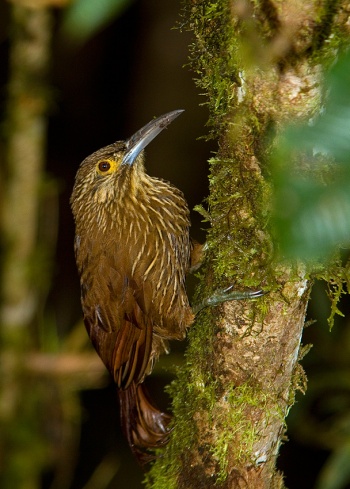| (3 intermediate revisions by one other user not shown) | |||
| Line 1: | Line 1: | ||
| − | [[Image: | + | [[Image:Strong-billed_Woodcreeperlg.jpg|thumb|350px|right|Photo by {{user|Leif+G|Leif G}}. <br>Location: Mindo Loma, [[Ecuador]]]] |
;[[:Category:Xiphocolaptes|Xiphocolaptes]] promeropirhynchus | ;[[:Category:Xiphocolaptes|Xiphocolaptes]] promeropirhynchus | ||
'''Includes Carajas Woodcreeper''' | '''Includes Carajas Woodcreeper''' | ||
| Line 9: | Line 9: | ||
[[Belize]], [[Bolivia]], [[Brazil]], [[Colombia]], [[Costa Rica]], [[Ecuador]], [[El Salvador]], [[Guatemala]], [[Guyana]], [[Honduras]], [[Mexico]], [[Nicaragua]], [[Panama]], [[Peru]], and [[Venezuela]]. Found on both slopes of the Andes in [[South America]]. | [[Belize]], [[Bolivia]], [[Brazil]], [[Colombia]], [[Costa Rica]], [[Ecuador]], [[El Salvador]], [[Guatemala]], [[Guyana]], [[Honduras]], [[Mexico]], [[Nicaragua]], [[Panama]], [[Peru]], and [[Venezuela]]. Found on both slopes of the Andes in [[South America]]. | ||
==Taxonomy== | ==Taxonomy== | ||
| − | + | There are about 18 subspecies. | |
| + | |||
| + | ''X. p. carajaensis'' was split as '''Carajas Woodcreeper''' by Clements (2007), but is now (Clements, 2010)<sup>[[#References|[1]]]</sup> included in this taxon . | ||
| + | |||
==Habitat== | ==Habitat== | ||
Humid subtropical and temperate forests. | Humid subtropical and temperate forests. | ||
| Line 16: | Line 19: | ||
Flies directly to positions low on tree trunks, then moves steadily upwards, gleaning insects. | Flies directly to positions low on tree trunks, then moves steadily upwards, gleaning insects. | ||
| + | ==References== | ||
| + | #{{Ref-Clements6thDec10}} | ||
| + | {{ref}} | ||
==External Links== | ==External Links== | ||
{{GSearch|Xiphocolaptes+promeropirhynchus}} | {{GSearch|Xiphocolaptes+promeropirhynchus}} | ||
Latest revision as of 18:28, 13 June 2012
- Xiphocolaptes promeropirhynchus
Includes Carajas Woodcreeper
Identification
A large (28-30.5cm) woodcreeper with representative coloration of that family: Dark brown and russet back, lighter brown underparts with buff dots and streaking on the head, chest, and nape. Tail has characteristic hooked tips to help support the bird in its typical vertical position on tree trunks. Most easily identified by the size of the bird and its bill, both of which are exceptional in its range.
Distribution
Belize, Bolivia, Brazil, Colombia, Costa Rica, Ecuador, El Salvador, Guatemala, Guyana, Honduras, Mexico, Nicaragua, Panama, Peru, and Venezuela. Found on both slopes of the Andes in South America.
Taxonomy
There are about 18 subspecies.
X. p. carajaensis was split as Carajas Woodcreeper by Clements (2007), but is now (Clements, 2010)[1] included in this taxon .
Habitat
Humid subtropical and temperate forests.
Behaviour
Flies directly to positions low on tree trunks, then moves steadily upwards, gleaning insects.
References
- Clements, JF. 2010. The Clements Checklist of Birds of the World. 6th ed., with updates to December 2010. Ithaca: Cornell Univ. Press. ISBN 978-0801445019. Spreadsheet available at http://www.birds.cornell.edu/clementschecklist/Clements%206.5.xls/view
Recommended Citation
- BirdForum Opus contributors. (2024) Strong-billed Woodcreeper. In: BirdForum, the forum for wild birds and birding. Retrieved 22 December 2024 from https://www.birdforum.net/opus/Strong-billed_Woodcreeper




